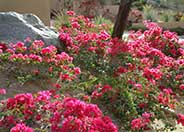
Common name:Bougainvillea, La Jolla
Botanical name:Bougainvillea 'La Jolla'
The large amount of flamboyant color on this species creates a wonderful accent in a garden. Varieties can be in bush or vine form; colors vary. Once established, they tend to be carefree. All varieties are susceptible to frost damage. 'La Jolla' blooms in bright red; it is a compact shrub and good for containers.
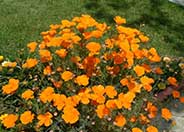
Common name:California Poppy, Golden Poppy
Botanical name:Eschscholzia californica
This small annual (sometimes acts as a perennial) plant will grow to less than 1' tall and has light, small blue green leaves with gold and orange flowers that bloom in spring and summer.
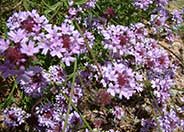
Common name:Cedros Island Verbena
Botanical name:Verbena lilacina 'De La Mina'
Verbena lilacina 'De La Mina' is a selection introduced by the Santa Barbara Botanical Garden. It is a fast-growing shrub that reaches 3' tall and 3' wide. Flowers are purple and fragrant and bloom all year long in coastal areas. These star-shaped flowers are held high above the mound shaped foliage. It does well in sun and part sun and is considered drought tolerant. It is a beautiful shrub that attracts butterflies.
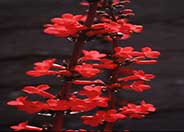
Common name:Red Rose Penstemon
Botanical name:Penstemon superbus
Red Rose Penstemon has vivid coral flowers along 3' stalks bloom from April to May. Leaves are blue green, 4"long, and 1.5" wide. The foliage is often purplish.
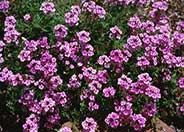
Common name:Verbena
Botanical name:Verbena peruviana
This perennial forms a flat mat that covers an area rapidly. It has dark green leaves with clusters of bright flowers that bloom all year. Hybrids will have a little more height, different flower colors and spread more slowly. It is drought tolerant.
Dealing With Drought
More than half of the water used at your home is for outside purposes. Studies show that on average, half of the water used outdoors is wasted. The leading cause of waste is incorrectly set and poorly managed irrigation controllers. The second biggest cause of wastage is broken irrigation equipment that goes undetected. There are a few basic things you can do to make a big difference in your water use.
Click in the green box for more information
| Designer: | Dry Creek Bed in the Side Yard |
Photographer: GardenSoft |
Soils and Compost:
Maintain a two to four inch layer of mulch on the soil surface to reduce weeds, infiltrate rain water, and reduce compaction.
Integrated Pest Management:
Attract, or buy beneficial insects such as ladybugs and lacewings to control pest outbreaks in your garden.

